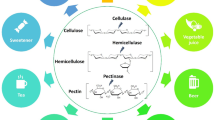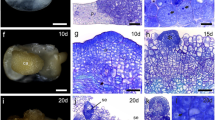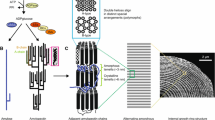Summary
Two pure, homogeneous xyloglucan-hydrolyzing enzymes from germinated nasturtium seeds have been used to localize xyloglucans specifically in seed cell walls. The enzymes, a novelendo (1→4)-β-d-glucanase which shows absolute specificity towards xyloglucans and a β-d-galactosidase which is capable of removing galactosyl residues from polymeric xyloglucans, were used to stabilize gold sols. The complexes were applied to ultrathin sections of nasturtium (Tropaeolum majus L) and tamarind (Tamarindus indica L) seeds. The gold complexes prepared from the active enzyme proteins retained enzyme activity, and such complexes gave extremely weak section-labelling or no labelling at all. When the enzymes were subjected to heat-deactivation before being used to stabilize the gold sols, gold complexes were obtained which lacked enzyme activity, but which gave strong, specific labelling of xyloglucans in ultrathin sections. The specificity of the labelling was checked by substrate-competition, by pretreatment of sections with the active and heat-denaturated enzymes and by comparing the labelling of xyloglucan-containing storage cells with other cell types in the same section. The labelling was maximal at the pH which was optimal for the active enzyme. We conclude that the enzyme-gold complexes which retain high activity against the substrate to be localized are likely to be unsuitable as cytochemical probes because they may causein situ substrate modification. In the case of the enzyme complexes described here the specific localization obtained with the gold complexes prepared from heat deactivated enzymes may be attributable to the retention by the heat-treated enzymatically-inactive proteins of substrate recognition. Alternatively, some recovery of the native configuration of the heat-denatured protein may have occurred on adsorption to the surface of the colloidal gold particle.
Similar content being viewed by others
References
Bendayan, M. (1984) Enzyme-gold electron microscopic cytochemistry: a new affinity approach for the ultrastructural localization of macromolecules.J. Electron Microsc. Techn. 1, 349–72.
Bendayan, M. &Benhamou, N. (1987) Ultrastructural localization of glucoside residues by applying the enzyme-gold approach.J. Histochem. Cytochem. 35, 1149–55.
Benhamou, N. (1989) Cytochemical localization of β-(1→4)-d-glucans in plant and fungal cells using an exoglucanase-gold complex.Electron Microsc. Rev. 2, 123–38.
Benhamou, N. &Ouellette, G. B. (1986) Use of pectinases complexed to colloidal gold for the ultrastructural localization of polygalacturonic acids in the cell walls of the fungusAscocalyx abietina.Histochemical J. 18, 95–104.
Berg, R. H., Erdos, G. W., Gritzali, M. &Brown, R. D. (1988) Enzyme-gold affinity labelling of cellulose.J. Electron Microscop. Techn. 8, 371–9.
Dawson, R. M. C., Elliot, D. C., Elliot, W. H. &Jones, K. M. (1982)Data for Biochemical Research. Oxford: Clarendon Press.
Edwards, M., Dea, I. C. M., Bulpin, P. V. &Reid, J. S. G. (1985) Xyloglucan (amyloid) mobilisation in the cytoledon ofTropaeolum majus seeds following germination.Planta 163, 133–40.
Edwards, M., Dea, I. C. M., Bulpin, P. V. &Reid, J. S. G. (1986) Purification and properties of a novel xyloglucan-specificendo-(1→4)-β-d-glucanase from germinated nasturtium seeds (Tropaeolum majus L.).J. Biol. Chem. 261, 9489–94.
Edwards, M., Bowman, Y. J. L., Dea, I. C. M. &Reid, J. S. C. (1988) A β-d-Galactosidase from Nasturtium (Tropaeolum majus L.) cotyledons. Purification, properties and demonstration that xyloglucan is the natural substrate.J. Biol. Chem. 263, 4333–7.
Frens, G. (1973) Controlled nucleation for the regulation of the particle size in monodisperse gold solutions.Nature (London), Phys. Sci. 241, 20–2.
Fry, S. C. (1986) Cross-linking of matrix polymers in the growing cell walls of Angiosperms.Annu. Rev. Plant Physiol. 37, 165–86.
Knox, J. P., Lindstead, P. J., King, J., Cooper, C. &Roberts, K. (1990) Pectin esterification is spatially regulated both within cell walls and between developing tissues of root apices.Planta 181, 512–21.
Londono, I. &Bendayan, M. (1987) Ultrastructural localization of mannoside residues on tissue sections: comparative evolution of the enzyme-gold and the lectin-gold approaches.Eur. J. Cell Biol. 45, 88–96.
McNeil, M., Darvill, A. G., Fry, S. C. &Albersheim, P. (1984) Structure and function of the primary cell walls of plants.Annu. Rev. Biochem. 53, 625–63.
Moore, P. J., Darvill, A. G., Albersheim, P. &Staehelin, L. A. (1986) Immunogold localization of xyloglucan and rhamnogalacturonan I in the cell walls of suspension-cultured sycamore cells.Plant Physiol. 82, 787–94.
Moore, P. J. &Staehelin, L. A. (1988) Immunogold localization of the cell wall matrix polysaccharides rhamnogalacturonan I and xyloglucan during cell expansion and cytokinesis inTrifolium pratense L: implication for secretory pathways.Planta 174, 433–45.
Northcote, D. H., Davey, R. &Lay, J. (1989) Use of antisera to localize callose, xylan and arabinogalactan in the cell-plate, primary and secondary walls of plant cells.Planta 178, 353–66.
Reid, J. S. C., Edwards, M. &Dea, I. C. M. (1988) Enzymatic modification of natural seed gums. InGums and stabilizers for the food industry (edited byPhillips, S. O., Wedlock, D. J. &Williams, P. A.) Vol. 4, pp. 391–8. Oxford: IRL Press.
Reis, D., Vian, B., Darzens, D. &Roland, J. C. (1987) Sequential patterns of intramural digestion of galactoxyloglucan in tamarind seedlings.Planta 170, 60–73.
Roland, J. C., Reis, D., Vian, B. &Roy, S. (1989) The helicoidal plant cell walls as a performing-based composite.Biol. Cell 67, 209–20.
Roth, J. (1983) The colloidal gold marker system for light and electron microscopic cytochemistry. InTechniques in immunocytochemistry (edited byBullock, G. R. &Petrutz, P.) Vol. 2, pp. 217–84. London: Academic Press.
Ruel, K. &Joseleau, J. P. (1984) Use of enzyme-gold complexes for the ultrastructural localization of hemicelluloses in the plant cell wall.Histochemistry 81, 573–80.
Ruel, K., Joseleau, J. P. &Franz, G. (1990) Aspects cytologiques de la formation des xyloglucanes dans les cotylédons des graines deTropaeolum majus L. (Capucine).J. R. Acad. Sci. 310, 89–95.
Vian, B. (1986) Ultrastructural localization of carbohydrates. Recent developments in cytochemistry and affinity methods. InBiology and molecular biology of plantpathogens interaction, NATO ASI Series, (edited byBailey, J.) pp. 49–57. Berlin: Springer-Verlag.
Vian, B., Brillouet, J. M. &Satiat-Jeunemaitre, B. (1983) Ultrastructural visualization of xylans in cell walls of hardwood by means of xylanase-gold complex.Biol. Cell 49, 179–82.
Vian, B., Reis, D., Mosiniak, M. &Roland, J. C. (1987) The glucuronoxylans and the helicoidal shift in cellulose microfibrils in linden wood: cytochemistryin muro and on isolated molecules.Protoplasma 131, 185–99.
Vian, B. &Roland, J. C. (1987) The helicoidal cell wall as a time register.New Phytol 105, 345–57.
Author information
Authors and Affiliations
Rights and permissions
About this article
Cite this article
Vian, B., Nairn, J. & Reid, J.S.G. Enzyme-gold cytochemistry of seed xyloglucans using two xyloglucan-specific hydrolases. Importance of prior heat-deactivation of the enzymes. Histochem J 23, 116–124 (1991). https://doi.org/10.1007/BF01047456
Received:
Revised:
Issue Date:
DOI: https://doi.org/10.1007/BF01047456




